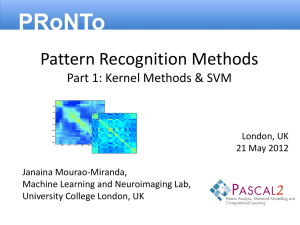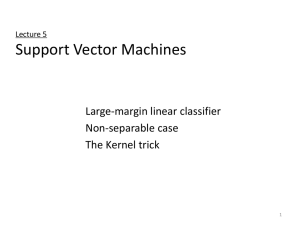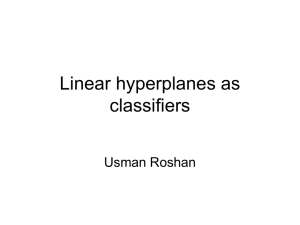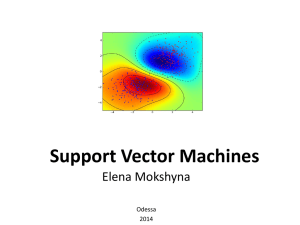Lecture 24: Classification V, SVMs
advertisement
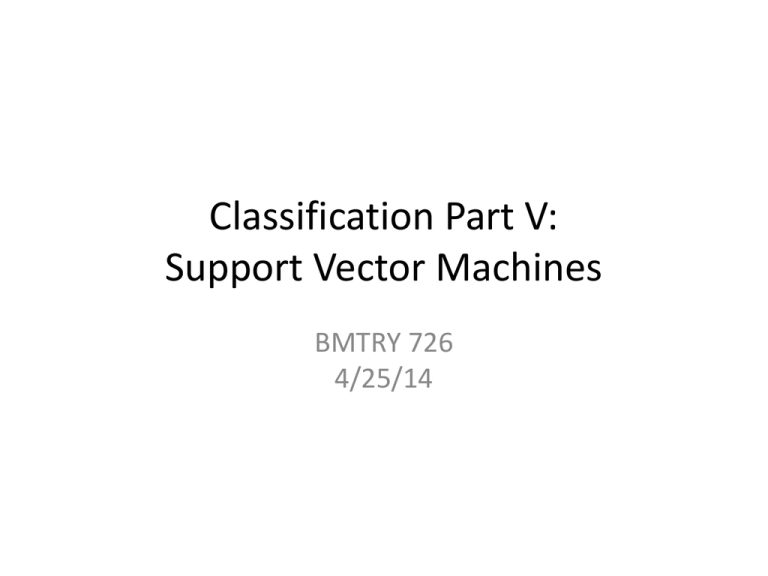
Classification Part V: Support Vector Machines BMTRY 726 4/25/14 What are SVMs? • Non-probabilistic (sort of) binary linear classifier, allowing identification of 2 groups • Generalization of linear decision boundaries • Can be linear and non-linear classifiers • Basic SVM is an algorithm for optimizing a convex loss function with respect to a given binary outcome – Scalable for multi dimensional data – Unaffected by local minima What are SVMs? • This is a decision machine, it does not provide posterior probabilities – There have been attempts to elicit posterior probabilities • Relevance Vector Machine (RVM) is a Bayesian formulation and has posterior outputs, much sparser solutions than SVMs – Beyond the scope of this lecture (and class) Examples of Uses of SVMs • Identifying fraudulent and real credit card transactions • Determination of SPAM email • Identifying hand written digits, image processing • Automatic classification of gene expression profiles or Mass spectroscopy data • Classify DNA or Protein sequences Basic components of a SVM • • • • Separating hyperplane Maximum-margin of the hyperplane Soft margin Kernel function Simple Example • Microarray expression data from patients with acute leukemia – Both acute lymphoblastic (ALL) and acute myeloid (AML) leukemias • We want to identify type of leukemia based on expression data from patients • From a much larger data set by Golub et al. Example Data • Start by considering two genes for each patient. • Each gene is represented as an RNA expression level of the given gene • The training data can be described, where x is our data and y is the class of that data point D x , y x R , y 1,1 2 i i i i 2-Gene Example • If there truly were only 2 genes, coming up with a classification rule might be easy • Consider the graph below… – But what about 4+ dimensions – Or more likely (in gene expression) thousands of dimensions The Separating Hyperplane • The hyperplane is the decision boundary an SVM uses to distinguish one object from another • It is a flat n-1 dimension subspace of a n dimensional space, separating the original space into 2 parts – A dot on a line – A line on a 2-D space – A plane in a 3-D volume… The Separating Hyperplane • Regardless of original dimension, the hyperplane is the separating line between ALL and AML • Sometimes a 1 or 2-D hyperplane is sufficient • But what about 5 or 6 or the whole 6,817 genes of the original data set • This can be extrapolated mathematically Which Hyperplane • There are many hyperplanes and a subset of these separate the two categories • The job of SVM is to distinguish the “best” hyperplane from among those that separate the data -i.e. which provides the best classifier? Linear Support Vector Machines • In the binary classification problem, the construct a function such that Given data: D xi , yi xi R 2 , yi 1,1 ,i 1, 2,...,n Classify according to: C x sign f x • The separating function then classifies a new point depending on whether or not the classifier is positive Linearly Separable Data • Consider case where the data are linearly separable, the data can then be separated by a hyperplane: f x 0 x' • To choose the “best” hyperplane, define: – d- = shortest distance from the separating hyperplane and the nearest negative datapoint – d+ = shortest distance from the separating hyperplane and the nearest positive datapoint • The margin is then defined as : d = d- + d+ • The “best” hyperplane maximizes this margin and is defined as the the maximum marginal classifier. The Maximal Margin Hyperplane • This hyperplane is defined by a middle line (i.e. the margin) which separates the classes but keeps a max distance from any one point. • Model parameters are a convex optimization problem, thus a local solution is a global optimum • The end result is that the hyperplane is dominated by nearby data points • The points that fall on the hyperplanes defined by d- and d+ are called the support vectors (hence SVMs) Margin H-1=(0+1)+x’ 0+x’ dd+ H+1=(0-1)+x’ Linear Support Vector Machines • If the data are linearly separable, then there are 0 and for which: 0 x' 1 if yi 1 0 x' 1 if yi 1 • We can combine these inequalities: yi 0 x' 1 i 1, 2,...,n • To find the optimal hyperplane we want to find the 0 and minimize subject to 1 2 2 yi 0 x' 1 i 1, 2,...,n • This is a convex (constrained) optimization problem that is solved using Lagrangian multipliers Linearly Non-Separable Data • Up to now we had been assuming the data are perfectly linearly separable • In reality, data are rarely linearly separable (i.e. we expect some overlap) • As a result, one or more of the constraints placed in solving the optimization problem will be violated • We can deal with this problem by introducing two concepts: – A soft-margin allows a few variables to cross into the margin or over the hyperplane, allowing misclassification – A slack variable, x, that defines the distance from a point on the wrong side of H- or H+ The Soft Margin • We penalize the crossover by looking at the number and distance of the misclassifications • This is a trade off between the hyperplane violations and the margin size • The slack variables are bounded by some set cost • The farther they are from the soft margin, the less influence they have on the prediction More on the Soft Margin • All observations have an associated slack variable – x = 0 for all points on the margin (or correct side of the margin) – x > 0 for a point in the margin or on the wrong side of the hyperplane – C is the trade off between the slack variable penalty and the margin • When allowing error, we optimize our hyperplane by: C i 1xi 2 n minimize 1 2 subject to xi 0 and yi 0 x' 1 xi Nonlinear Support Vector Machines • As we’ve discussed previously, a linear classifier is often not appropriate • We could consider non-linear transformations of our x’s using some nonlinear mapping: : r H where H is an N H dim feature space and x 1 x ,...,N H x • The transformed sample is: x* , y • We can substitute x for x when developing our SVM and the optimization only depends on: x , x* Kernel Trick • The “new” feature space defined by H may be very large and as such it is difficult to calculate x , x* • However, this is not a problem as in practice, SVMs use the kernel trick to find the optimal hyperplane • The basic idea to avoid directly computing x , x* – The kernel trick is an algorithm for computing this inner product – Compute it using a non-linear kernel function: K x , x* x , x* – Then compute a linear SVM using this The Kernel Function • If the data are not linearly separable in the given form… • We can use a kernel function to project our data into a higher dimensional space • OR use the kernel function to project into a lower dimensional space (to simplify or remove noise) We cannot separate these with a point hyperplane We project from 1-D to 2-D space with Y=X2 Example of the Kernel Trick • Consider data with 2 input features X1 and X2 • Let’s look at a polynomial kernel of degree 2: K x,x* x,x* c 2 Higher Dimension Projection • We can project into even higher dimensions, then project the hyperplane back into a visual dimension • There is a kernel to allow linear separation of any consistent data set • The curse of dimensionality, use of too high a dimension will lead to over fitting the data Projectedfrom 2-D into 4-D to find the hyperplane, then projecting that hyperplane back into 2-D space Over fitting by projecting into to high of a dimensional space The “Right” Kernel • A matter of trial, error, and experience • Types of simple Kernels – Linear: K x,y x' y c • Equivalent to the non-kernel – Polynomial: K x, y x, y c d • Non-linear, good for normalized training data – Gaussian: K x, y exp xy • Sigma plays the role of determining how sensitive the hyperplane is to noise in the training data if underestimated, and the function will behave linearly if it is too large Optimizing the Kernel • We need to determine a few things when optimizing a kernel – Optimize C, the cost of being on the wrong side of the margin – For different kernels, we can optimize all parameters that are not included in the feature space • Optimization can be done using a grid search Optimizing the Kernel • Grid search: – Select several starting values for the cost • 10, 100, 1000, 10000 – Select several values for the kernel parameters • e.g. for the Gaussian kernel we must find g = 1/ • Choose values such as 10-6-10-3 – Conduct a k-fold cross-validation with each combination of parameters and estimate error rate – Choose those values that provide the two best error rate ranges and repeat the grid search with more refined values Multiple Classes Problem • Our focus has been on binary classification but what is k > 2? • Common approaches: – One vs. all SVMs for a classes – One vs. one SVMs • each point classified by multiple SVMs and the choice with the highest count determines classification. • Often suggested that the one vs. one approach is better (and oddly not more computationally difficult) • There are also several true multi-class approaches that have been developed but not readily available A Example Application • Prediction of RNA-protein binding residues • Involved in transcription regulation, splicing and protein synthesis • This problem has been tackled by several different methods in the past – ANNs, Naïve Bayes classifiers (NBc), SVMs Training Data • From BR144, 144 protein-RNA complexes with annotated residues – 4304 binding residues – 27937 non-binding residues – very low sequence similarity • Data includes: – Sequence data (PSI-BLAST profile) – Accessible surface area (ASA) – residue location and correlation with interface regions – Betweeness-centrality (BC)– A node’s relative importance in a network, calculated from a spatial patch – Retention coefficeint (RC) - ability to hold peptide nucleic acids in that region, at pH of 2 Region selection • Initially evaluated the predictive power of binding residues of all amino acid indicies in the AAIndex database • This established a baseline for prediction accuracy based on a single residue feature Region selection • Next step was to examine the impact on prediction accuracy by considering the aa’s “near” an interface residue • Refer to these regions as “patches” and they are defines by three different measures of nearness Defined by ordering in chain Euclidian distance between carbon atoms of residues Vertices with smallest geodesic distance to the central vertex Prediction • A test against tRNA psudouridine synthase (IRE3:A) front binding cleft True positive True negative False positive False negative back Known True binding (yellow) SVM predicted Binding (yellow) Comparison Method Comparison Implementation • Let’s look at software


